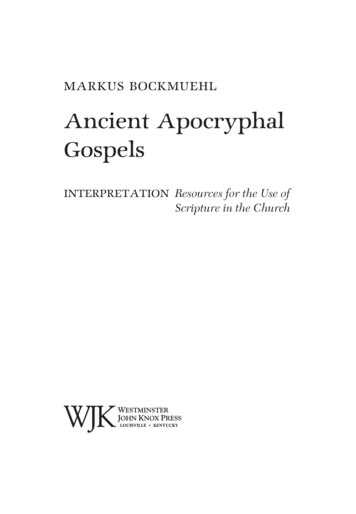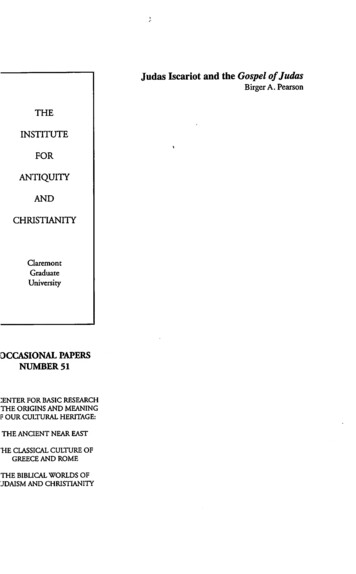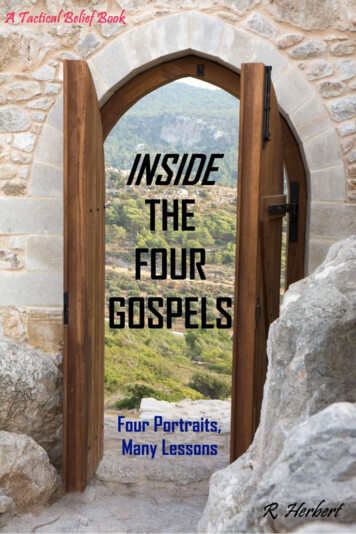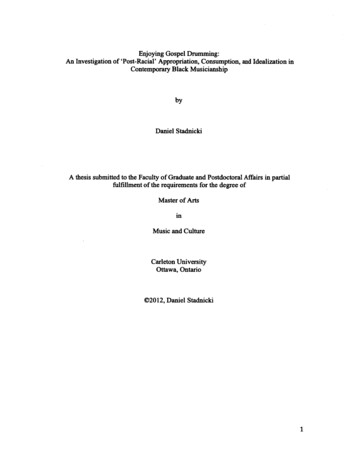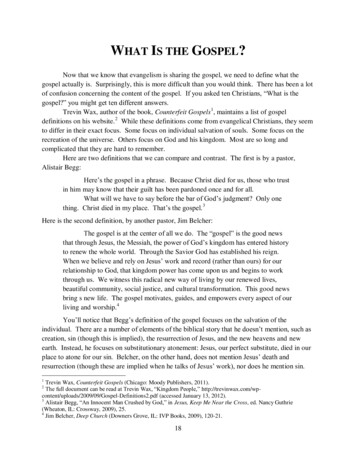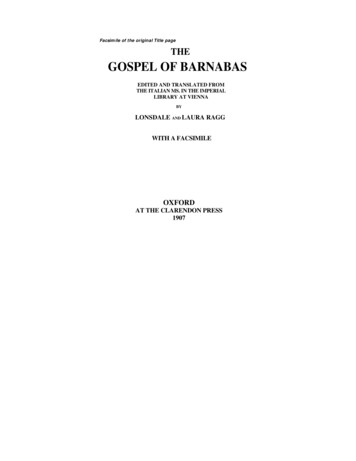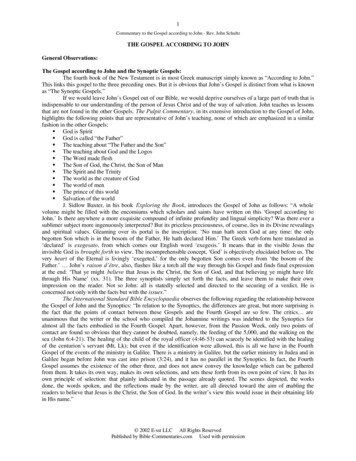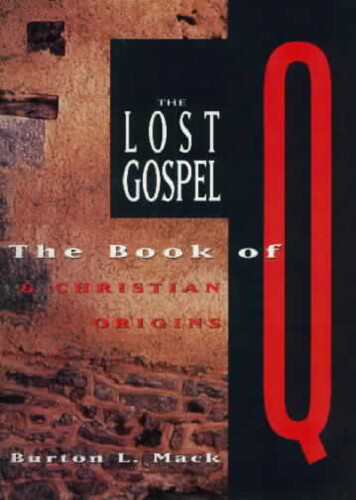
Transcription
THE LOST GOSPELThe Book ofQ&Christian OriginsBURTON L. MACKMM HarperSanFranciscoA Division of HarperCollins/W &/ ers
DESIGNDesign Office / Bruce KortebeinTHE LOST GOSPEL. Copyright 1993 byBurton L. Mack. All rights reserved.Printed in the United States of America.No part of this book may be used or reproduced in any manner whatsoever withoutwritten permission except in the case ofbrief quotations embodied in critical articles and reviews. For information addressHarperCollins Publishers, 10 East 53rdStreet, New York, NY 10022.FIRST EDITIONLibrary of Congress Cataloging-in-Publication DataMack, Burton L.The lost gospel: the book of Q & Christian origins / Burton L.Mack. — 1st ed.p.cm.Includes bibliographical references and index.ISBN 0-06-065374-4 (alk. paper)1. Q hypothesis (Synoptics criticism) 2. Christianity—Origin.I. 93 94 95 96 97 RRD(H) 10 9 8 7 6 5 4 3 2 1This edition is printed on acid-free paperthat meets the American NationalStandards Institute Z39.48 Standard.
in memory ofHANS CONZELMANNa teacher ofgrace and truth
CONTENTSPROLOGUEPART i1.2.3.4.The ChallengeThe Discovery of a Lost GospelFinding the ShardsAn Uncommon WisdomRemoving the PatinaGalilee Before the WarThe Text of the Lost Gospel5. The Book of Q115294151PART IIPART in6.7.8.9.PART iv10.11.12.13.EPILOGUE71The Recovery of a Social ExperimentDancing to the PipesSinging a DirgeClaiming a PlaceComing to Terms105131149171The Reconception of Christian OriginsJesus and AuthorityMythmaking and the ChristBishops and the BibleChristians and Their Myth191207227237The Consequences245Appendix A: Early Christian LiteratureAppendix B: Q SegmentsSelect BibliographyIndex259260263269Vll
THE LOST GOSPEL
PROLOGUEThe Challenge n c e upon a time, before there were gospels of the kindfamiliar to readers of the New Testament, the first followers of Jesuswrote another kind of book. Instead of telling a dramatic story aboutJesus' life, their book contained only his teachings. They lived withthese teachings ringing in their ears and thought of Jesus as thefounder of their movement. But their focus was not on the person ofJesus or his life and destiny. They were engrossed with the social program that was called for by his teachings. Thus their book was not agospel of the Christian kind, namely a narrative of the life of Jesus asthe Christ. Rather it was a gospel of Jesus' sayings, a "sayings gospel."His first followers arranged these sayings in a way that offered instruction for living creatively in the midst of a most confusing time, andtheir book served them well as a handbook and guide for most of thefirst Christian century.Then the book was lost. Perhaps the circumstances changed, orthe people changed, or their memories and imagination of Jesuschanged. In any case, the book was lost to history somewhere in thecourse of the late first century when stories of Jesus' life began to bewritten and became the more popular form of charter document forearly Christian circles.It makes some difference whether the founder of a movement isremembered for his teachings, or for his deeds and destiny. For thefirst followers of Jesus, the importance of Jesus as the founder of their1
PROLOGUE2movement was directly related to tue significance they attached to histeachings. What mattered most was the body of instructions that circulated in his name, what these teachings called for in terms of ideas,attitudes, and behavior, and the difference these instructions made inthe lives of those who took them seriously. But as the Jesus movement spread, groups in different locations and changing circumstances began to think about the kind of life Jesus must have lived.Some began to think of him in the role of a sage, for instance, whileothers thought of him as a prophet, or even as an exorcist who hadappeared to rid the world of its evils. This shift from interest in Jesus'teachings to questions about Jesus' person, authority, and social roleeventually produced a host of different mythologies.The mythology that is most familiar to Christians of today developed in groups that formed in northern Syria and Asia Minor. ThereJesus' death was first interpreted as a martyrdom and then embellished as a miraculous event of crucifixion and resurrection. Thismyth drew on hellenistic mythologies that told about the destiny of adivine being (or son of God). Thus these congregations quickly turnedinto a cult of the resurrected or transformed Jesus whom they nowreferred to as the Christ, or the Lord, as well as the Son of God. Thecongregations of the Christ, documented most clearly in the letters ofPaul from the 50s, experienced a striking shift in orientation, awayfrom the teachings of Jesus and toward the spirit of the Christ whohad died and was raised from the dead. It was this myth that eventually made the narrative gospels possible.Narrative gospels began to appear during the later part of the firstcentury. Mark's gospel was written during the 70s, Matthew's duringthe 80s, John's during the 90s, and Luke-Acts sometime early in thesecond century. These gospels combined features of the martyr mythfrom the Christ cult with traditions about Jesus as he had been remembered in the Jesus movements, thereby locating the significanceof Jesus in the story of his deeds and destiny. Naturally, these gospelscame to a climax in an account of his trial, crucifixion, and resurrection from the dead. They followed a plot that was first worked out byMark during the 70s in the wake of the Roman-Jewish war. The plotcollapsed the time between the events of Jesus' life and the destruction of the Jerusalem temple which took place during the war. Markachieved this plot by making connections between two sets of events
PROLOGUE(Jesus' death and the temple's destruction) that could only have beenimagined after the war. His gospel appears to have been the earliestfull-blown written composition along these lines, but once it was conceived, all of the narrative gospels used this same basic plot.According to the story line of the narrative gospels, Jesus wasdestined to come into conflict with the rulers of the world because heappeared in the world as the very son of God. This conflict escalatedto a climax in the crucifixion of Jesus as the Christ, but would only befinally resolved when Jesus as the resurrected son of God appeared atthe end of time to judge the world and establish a new social order asthe reign or kingdom of God. In the meantime, both the resurrectionof Jesus and the destruction of the temple were thought to establishthe truth of God's great plan.The first followers of Jesus could not have imagined, nor did theyneed, such a mythology to sustain them in their efforts to live according to his teachings. Their sayings gospel was quite sufficient for theJesus movement as they understood it. Even after the narrativegospels became the rage, the sayings gospel was still intact. It was stillbeing copied and read with interest by ever-widening circles. And itwas available in slightly different versions in the several groups thatcontinued to develop within the Jesus movement. Eventually, thenarrative gospels prevailed as the preferred portrayal for Christians,and the sayings gospel finally was lost to the historical memory of theChristian church.Were it not for the fact that two authors of narrative gospels incorporated sizable portions of the sayings gospel into their stories ofJesus' life, the sayings gospel of the first followers of Jesus would havedisappeared without a trace in the transitions taking place. We neverwould have known about the Jesus movements that flourished priorto the Christian church. But Matthew and Luke each had a copy ofthe sayings gospel, and the material each copied from it largely overlapped. It was this fortuitous coincidence that made it possible in recent times to recover the book, even though the sayings now soundlike the pronouncements of the son of God instead of the teachings ofJesus.No modern historian ever imagined that a sayings gospel hadonce existed, so no one went looking for it. Scholars discovered itinadvertently while poring over the gospels of the New Testament,
PROLOGUE4wondering which had been written first. As they set the gospels sideby side for comparison, they noticed two kinds of correspondence.One correspondence was that the story line in Matthew and Lukeagreed only when it followed the gospel of Mark. This finding meantthat Mark was the earliest narrative gospel and the source for the plotused by Matthew and Luke. But the other correspondence was also ofinterest. Matthew and Luke contained a large quantity of sayings material not found in Mark and much of this material was identical. Thiscorrespondence meant that Matthew and Luke had used a secondwritten document in addition to the gospel of Mark. Scholars calledthis document Q as a shorthand for Quelle, which means "source" inGerman, for they first thought of it only as the common source for thesayings in the gospels of Matthew and Luke. But once Q was recognized as a source for these gospels, it could be studied on its own. Andso the book of the first followers of Jesus has come to light after beinglost for almost eighteen hundred years. In keeping with scholarly tradition, I call this lost gospel Q, for it has no other proper name.By reading Q carefully, it is possible to catch sight of those earliest followers of Jesus. We can see them on the road, at the market,and at one another's homes. We can hear them talking about appropriate behavior; we can sense the spirit of the movement and their attitudes about the world. A sense of purpose can be traced throughsubtle changes in their attitudes toward other groups over a period oftwo or three generations of vigorous social experimentation. It is alively picture. And it is complete enough to reconstruct the historythat happened between the time of Jesus and the emergence of thenarrative gospels that later gave the Christian church its official account of Christian beginnings.The remarkable thing about the people of Q is that they were notChristians. They did not think of Jesus as a messiah or the Christ. Theydid not take his teachings as an indictment of Judaism. They did notregard his death as a divine, tragic, or saving event. And they did notimagine that he had been raised from the dead to rule over a transformed world. Instead, they thought of him as a teacher whose teachings made it possible to live with verve in troubled times. Thus theydid not gather to worship in his name, honor him as a god, or cultivate his memory through hymns, prayers, and rituals. They did notform a cult of the Christ such as the one that emerged among the
PROLOGUEChristian communities familiar to readers of the letters of Paul. Thepeople of Q were Jesus people, not Christians.This discovery upsets the conventional picture of the origins ofChristianity. The popular conception, based on the portrayal of Jesusin the narrative gospels, is that Jesus appeared as the Jewish messiahto reform the religion of Judaism. He challenged the teaching of thescribes and Pharisees, called the people to repentance, and instructedhis disciples to be leaders in a kingdom of God about to be inaugurated. Marching to Jerusalem, Jesus then cleansed the temple and announced its destruction, countered the Jewish authorities there, andwas crucified in keeping with a conflict of cosmic and apocalyptic proportions between the Jews and God's plan for his kingdom. At firstconfused following Jesus' death, the disciples regrouped when he appeared to them as the resurrected Lord and Son of God. They thenformed the first church in Jerusalem and started two great Christianmissions, one to the Jews and one to the gentiles. They did this in theconviction that the miracle of the resurrection was a sign that Jesus'proclamation of the kingdom of God was true and that God's finaljudgment upon the world had begun.None of this is reflected in the sayings gospel Q. In Q there is nohint of a select group of disciples, no program to reform the religionor politics of Judaism, no dramatic encounter with the authorities inJerusalem, no martyrdom for the cause, much less a martyrdom withsaving significance for the ills of the world, and no mention of a firstchurch in Jerusalem. The people of Q simply did not understand theirpurpose to be a mission to the Jews, or to gentiles for that matter.They were not out to transform the world or start a new religion.Q's challenge to the popular conception of Christian origins istherefore clear. If the conventional view of Christian beginnings is right,how are we to account for these first followers of Jesus? Did they fail toget his message? Were they absent when the unexpected happened?Did they carry on in ignorance or in repudiation of the Christian gospelof salvation? If, however, the first followers of Jesus understood thepurpose of their movement just as Q describes it, how are we to accountfor the emergence of the Christ cult, the fantastic mythologies of thenarrative gospels, and the eventual establishment of the Christianchurch and religion? Q forces the issue of rethinking Christian originsas no other document from the earliest times has done.
PROLOGUE6This book is about the lost gospel Q and its challenge to the conventional picture of Christian origins. In part I of the book the storyof Q's discovery and reconstruction is sketched in broad outline. Thefull history of scholarly machinations is not given, for this would require a lengthy rehearsal of detailed argumentation from an extensive scholarly bibliography. But the reader will want to know aboutthe major episodes in the scholarly quest for the earliest gospel, whyit took scholars so long to recognize Q as a sayings gospel particular tothe early Jesus movements, and what to make of a text that existsonly in the form of its two citations in Matthew and Luke. A sketch ofthis history need not be boring, for it dips in and out of a rather romantic search for the Jesus of history that takes some twists and turnsthat are decidedly humorous in retrospect. This part of the book setsthe stage for a closer look at the lost gospel itself.Part II offers an English translation of Q, together with a reader'sguide. This, along with an analysis of Q in part III, is the major contribution of the book.In part III, observations on the composition of the lost gospelshed light on the content of its teachings and literary history. This inturn will make it possible to trace the activities and experiences of theearly Jesus movement through five stages of social history. It is thispicture of a robust movement consciously taking its place in a world ofcompeting cultures that challenges the conventional view of Christian origins.In the course of the presentation in part III, it becomes clear thatnot all of the sayings in Q can actually be attributed to Jesus. To besure, all of the teachings in Q are ascribed to Jesus, but many of themaddress issues that could only have been encountered in the course oflater social experiences and they bear the marks of reflection on suchexperiences. This is not a phenomenon limited to Q or a practice thatwas peculiar to the people of Q. Scholars have collected several hundred sayings ascribed to Jesus from scattered literature of the first twoor three centuries. Of these sayings, only a handful may actually havebeen spoken by the historical Jesus. Scholars regularly acknowledgethis phenomenon by distinguishing between "authentic" and "inauthentic" sayings, defining those sayings that can be plausibly attributed to the historical Jesus as "authentic." But this does not explainthe phenomenon of attribution and hardly assuages the average
PROLOGUEreader's sense of exasperation when told that Jesus did not say whathis followers said he said. Thus the practice of attribution needs to beaddressed.Part IV offers the explanation that sayings came to be attributedto Jesus as part of the group's imaginative cultivation of its memorytraditions, namely its changing views of Jesus as the founder of themovement. This explanation draws on practices common to manypeople in antiquity and to major institutions, such as schools, duringGreco-Roman times. It is clear that the people of Q are not to becharged with fuzzy memories, ecstatic auditions, or crass deceit because they ascribed new sayings to a Jesus who was no longer alive.Attribution can be understood as a normal means of authorization forcertain types of founder figures.In the case of the people of Q, oriented as they were to the teachings of a teacher, the ascription of teachings to Jesus was a particularly appropriate form of mythmaking. Teachings attributed to Jesuswere invested with programmatic status and cultivated as instruction,embellished as rationale, outlined as ethical code, and used as signs ofrecognition. So solving the problem of "inauthentic" ascriptions doesmore than explain a feature of ancient sayings collections that peopletoday find unnerving; it will show that Q was much more than a collection of ad hoc instructions for the early Jesus people. Q's purposein attributing sayings to Jesus and its careful design can be seen as thecreation of a highly crafted and profoundly effective myth of origin.This myth of origin claimed epic and divine authority for Jesus as afounder figure without any need to entertain mythological notions ofa crucified and resurrected messiah.Thus Q's challenge to the conventional picture of Christian origins is more far-reaching than the making of a little room for yet another early Christian movement. The Jesus movement documentedby Q cannot be understood as a variant form of the Christian persuasion basic to the conventional picture of Christian origins. With Q inview the entire landscape of early Christian history and literature hasto be revised.Part IV proposes such a revision of early Christian history and literature. Scholars are well aware that the writings of the New Testament are a selection from a much larger body of early Christianliterature. They also account for the differences among the writings of
PROLOGUE8the New Testament by locating them in different streams of earlyChristian tradition, which are frequently defined by reference to aknown leading figure or author. Thus we have the Pauline tradition,the Johannine tradition, the Petrine tradition, and so on. BecauseNew Testament studies have been guided by an interest in the beliefsystems of early Christians, scholars refer to the differences among thetraditions as "theological." New Testament scholars know that thereare many different "theologies" represented in the writings of theNew Testament, and this fact provides a point of departure for discussing the many forms of early Christianity.But charting multiple theologies does not answer Q's challenge.The concept of many theologies leaves in place the assumption of asingular, miraculous, dramatic event or experience that may accountfor the many forms of early Christianity. By assuming a single originfor all early Christian traditions, which is usually thought to be theoverwhelming appearance and resurrection from the dead of the sonof God, multiple theologies can be understood merely as various attempts to explicate the mysterious meaning implicit in that divineoriginating moment. Q's challenge is that a vigorous Jesus movementwas generated without recourse to such an originating event, religious experience, or message of salvation. Q demonstrates that factors other than the belief that Jesus was divine played a role in thegeneration of early Jesus and Christ movements. What may those factors have been?The early Jesus movements were attractive as arenas for socialexperimentation called for by the troubled and difficult times. The frequent shifts in military power and political conquest unleashed by thecampaigns of Alexander the Great and the ensuing empires, from thePtolemies and Seleucids to the coming of the Romans, broke the ageold social patterns of life in the eastern Mediterranean. People continued to be identified and treated in terms of their ethnic extractionsand traditional cultures, but the social institutions of the old citystates and temple-states that had supported those cultures were goneforever. Uprooted cultural traditions collided in cities that filled withdisplaced populations. How to get along with each other in an ad hocworld was the critical question. Thus the times were right for thinking new thoughts about traditional values and for experimenting withfree association across ethnic and cultural boundaries.
PROLOGUEThe Jesus movement was attractive as a place to experimentwith novel social notions and life-styles. It was generated by a sensitive and considered awareness of the times and a critical posture toward reigning cultural values. Traditional systems of honor based onpower, wealth, and place in hierarchical social structures were calledinto question, as were codes of ritual purity, taboos on intercoursewith people of different ethnic roots, and taxation economies. Peoplewere encouraged to free themselves from traditional social constraintsand think of themselves as belonging to a larger human family. As Qputs it, "If you embrace only your brothers, what more are you doingthan others?"At first no one was in charge of the groups that formed aroundsuch teachings. Conversation and mutual support were enough to encourage an individual to act "naturally," as if the normal expectationsof acquiescence to social conventions did not apply. As groups formedin support of like-minded individuals, however, loyalty to the Jesusmovement strengthened, a social vision for human well-being wasgenerated within the group, and social codes for the movement had tobe agreed upon. Why not ask when in need and share what one hadwhen asked, they wondered? Eventually, therefore, the Jesus movement took the form of small groups meeting together as extended families in the heady pursuit of what they called God's kingdom.To explore human community based on fictive kinship withoutregard to standard taboos against association based on class, status,gender, or ethnicity would have created quite a stir, and would havebeen its own reward. Since there was no grand design for actualizingsuch a vision, different groups settled into practices that varied fromone another. Judging from the many forms of community that developed within the Jesus movement, as documented in literature thatbegins to appear toward the end of the first century, these groups continued to share a basic set of attitudes. They all had a certain criticalstance toward the way life was lived in the Greco-Roman world. Theyall struggled not to be determined by the emptiness of human pursuits in a world of codes they held to be superficial. And they alllearned to apply the concept of the kingdom of God to the ethos thatdeveloped in their own community. Despite these agreements, however, every group went its own way and drew different conclusionsabout what to think and do.
PROLOGUEConsideration of the experiences and human resources demanded by such social experimentation makes it possible, not only tomake room for the people of Q in the early history of the Jesus movement, but to understand all of the groups that formed as manifestations of a common quest for human community appropriate for thetimes. Part IV locates Q on the map of early Christian literature andintegrates the Jesus movement with other traditions that eventuallyfed into the making of Christianity. All early Christian texts can beplaced at specific junctures of a group's social history. Each text canthen be studied as an expression of a particular group's thought anddiscourse at that time. If one charts the various traditions of thoughtand theology, noting the shifts in social formation they reflect, eventhe eventual selection of texts represented by the New Testament canbe accounted for. Thus the story of Q comes full circle, ending with abrief account of the New Testament texts that made use of Q only toguarantee its erasure from the memory traditions of the Christianchurch. To understand the privilege granted the narrative gospels inthe New Testament of the Christian church is to understand why Qwas forgotten in time and why its recovery in recent years has createda bit of consternation among Christian scholars.Because the challenge of Q cannot be contained within scholarlycircles, the book closes with some thoughts on the role of the Christian gospel in contemporary American culture. If Q forces biblicalscholars and historians of religion to revise their understanding ofearly Christian history, a literate public should want to know about it.That in turn will make a difference in the way in which Christiansread the narrative gospels. The narrative gospels can no longer beviewed as the trustworthy accounts of unique and stupendous historical events at the foundation of the Christian faith. The gospels mustnow be seen as the result of early Christian mythmaking. Q forces theissue, for it documents an earlier history that does not agree with thenarrative gospel accounts.I have written the book with this challenge in mind. The issuesraised are profound and far-reaching. They are not issues of thoughtand conscience only for Christians. They make one ask about the reasons for popular attitudes toward the academy and especially for theease with which the academic study of religion can be dismissed. They
PROLOGUEmake one wonder about the abysmal lack of savvy on the part of themedia, critics of the fine arts, and public discourse when the subjectof religion and society is broached. And they strike to the heart of anentrenched reluctance in our society to discuss the mythic foundations for attitudes and values, both shared and conflictual, that influence the way we think, behave, and construct our institutions. Q canhardly be discussed without engaging in some honest talk aboutChristian myth and the American dream. If we take Q seriously, it willturn the quest for Christian origins into a question about our willingness to seriously engage in cultural critique.
PART ITHEDISCOVERYOF A L O S TGOSPEL
1Finding the ShardsiJ L n modern times adventurers, seekers of treasure, andarcheologists have discovered many ancient writings in ruins, caves,and old monastery libraries. Some of these finds have been early manuscripts of well-known writings, such as the biblical texts discoveredat St. Catherine's monastery in the 1850s or at Qumran in the 1940s.Others have been texts of writings known only by title because ofsome mention by an ancient author, but were thought to have beenlost, forgotten, or burned in the creedal wars of the fourth and fifthcenturies. Examples are the discovery of the Epistle of Barnabas at St.Catherine's in 1859 and the Didache, or "Teaching" (of the TwelveApostles), in the patriarchal library of Constantinople in 1875. Othershave come as complete surprises, such as many of the Dead SeaScrolls from the ancient library at Qumran and the Coptic-Gnostic library at Nag Hammadi discovered during the 1940s.In the quest to reconstruct the past, every new textual discoveryhas been greeted with some measure of enthusiasm and many findshave created sensations. New texts are exciting to scholars because oftheir promise of new knowledge and enticing to others because of asense that hidden secrets are about to be disclosed. In the case of Q'sdiscovery, however, there has been no announcement, little publicexcitement, and no sense that anything secret was about to be revealed. That is because Q was not discovered in some ancient cache.A manuscript of Q entitled "The Sayings of Jesus" did not suddenly
THE DISCOVERY OF A LOST GOSPELcome to light. Instead, the bits and pieces of this ancient writing werefound scattered about in the gospels of the New Testament, and thesewere very familiar texts. It was by chance, in the course of trackingdown the layered traditions of these gospels, that Q slowly emerged.Its existence at the bedrock of the Jesus traditions gradually forced itself upon scholars who hardly noticed the momentous significance oftheir discovery because the material was already so well known.The idea that there must have been a text like Q was firstthought of over 150 years ago, but its recognition as a document withits own distinctive history had to wait for the present generation ofscholars. One reason it took so long is that New Testament scholarshave been haunted by the desire to reconstruct the "life" of Jesus.They were therefore preoccupied with the eventful aspects of thegospels, worried about their miraculous features, not about the teachings which they took for granted. Another reason is that, since Q referred to a written source that was used in slightly different ways bytwo independent authors (Matthew and Luke), reconstructing a single, unified text for study and discussion was at first thought to be impossible. And a third reason is that many New Testament scholarsresisted the idea of Q because they thought there was no other example of the genre in early Christian literature and thus could not imagine why early Christians would have written such a text.However, as the comparative study of the gospels unfolded, thenature of Jesus' teaching eventually became a critical question. Waysto reconstruct the text of Q were developed. Another example of thegenre was found, the sayings gospel known as the Gospel of Thomas.And scholars finally turned to questions about Q's composition andcontent. A brief exploration of the major moments in this long historyof scholarship helps in understanding how and why Q finally emergedfrom the pages of the narrative gospels to challenge their own accountof Christian origins. In this chapter the story of Q's discovery as a written text will be told
and the sayings gospel finally was lost to the historical memory of the Christian church. Were it not for the fact that two authors of narrative gospels in corporated sizable portions of the sayings gospel into their stories of Jesus' life, the


